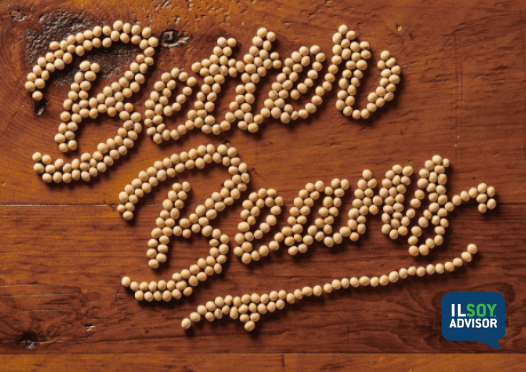ILSOYADVISOR POST
Better Yields. Better Profits: A Preview of the ILSoyAdvisor.com Peoria Soybean Summit
Better Yields. Better Profits: A Preview of the ILSoyAdvisor.com Peoria Soybean Summit
If you want bigger soybean yields and better profits—make sure the 2017 ILSoyAdvisor.com Soybean Summit in Peoria February 16 is on your calendar.
Illinois Field & Bean sat down with several of this year’s speakers; here’s a preview of some of the great information you’ll hear at the Summit.
Ag Outlook 2020: Short-term Bearish & Long-term Bullish
Steve Johnson, farm management specialist with Iowa State University
“Overall, 2016 will be another down year, despite record yields—USDA-Economic Research Service data indicates about a 15 percent drop in farm incomes,” says Johnson. The good news is that many farmers have learned to control cost.
“As we enter the fourth year of depressed prices, the most successful farmers are watching their margins, paying attention to cash flow and cost-cutting opportunities,” he notes.
Johnson offers the following recommendations to increase your odds of success in today’s economy.
- Manage cost
Look at your break-even cost—this starts with good record keeping. The better your records, the better decisions you can make to protect your bottom line.
• Take the time to do the calculations for your operation. You should know your total cost of production for every field you farm. Know what it really costs you to produce that crop on every acre. - Merchandise crops
We’re seeing tremendous yields this season, and growers should be proud of those numbers. They should do everything they can to leverage those bushels into dollars.
• Understand that you don’t need to hold onto those beans. Be prepared to take advantage of the seasonal swings we’ve seen each if the last three springs.
• It’s all about controlling what’s controllable, and farmers have more control than they think.
• You’ll be more effective if you have the right data—such as cost of production—and can better control your fixed costs. - Get past emotions
Farmers, like everyone, tend to be emotional. We oftentimes lack the discipline to react to changing market conditions.
• Don’t let the fear of loss, or hope for higher profits later, stop you from taking a profit.
• The key is to have a plan, one that includes a time objective, a price objective and an understanding of your cash flow needs.
• Develop a marketing plan based on your production costs and storage costs.
• Finally, share this plan with your lender. All of these things help take emotion out of your decision making.
How to accelerate agronomic gain with cutting edge technology and high end management
Kelli Bassett, field agronomist for DuPont Pioneer
How can growers take advantage of accelerated genetic gain? asks Bassett. It’s all about placing the right variety in the right environment to maximize the genetic yield potential. To this end, she’ll offer specific examples to help improve soybean variety and management decisions at the field level.
In addition, Basset will discuss the data behind the examples and recommendations to aid in the decision-making process for several key points, including:
- Environmental classification and influence on soybean yield.
• Field fertility, soil types and other factors must be part of your selection and management process. As a result, you must know, and make allowances for, field conditions as you select varieties. - Managing solar radiation capture throughout the growing season for greater yield
• Explore how altered planting dates change future decisions while maximizing sunlight soybeans capture throughout the entire season. Considerations include planting dates, disease management, pest avoidance and variety selection. - New technologies to accelerate genetic gain in soybeans
• Comparing new varieties against previous seed technology and what it means to soybean yield and management - What does genetic gain look like?
• Growing the soybean oil market with varieties containing altered fatty acid profiles
What have we learned from the Six Secrets of Soybean Success?
Jason Haegele, crop physiologist at WinField United
A multi-year, extensive research trial at the University Illinois lends further credence to the idea that tailoring soybean production to your specific situation can have significant yield and productivity benefits, explains Haegele.
“Our goal was to energize farmers about increasing soybean yields, while learning from the corn side of things,” he says. “The results shed light on the fact that we can see yield differences based on the decisions we make.”
The project:
- Identified management practices that have the greatest influence, including:
- Soil fertility
- Variety selection
- Foliar protection
- Exploring varietal differences and their response to agronomic practices
- While fertility had the largest effect, the trial found that the practices/decisions tend to be additive
Nutrient Management Recommendations for Profitable Soybean Production
Mike Staton, senior soybean educator, Michigan State University
Feeding your soybeans is usually the second largest production cost, and in this era of tight margins, it’s essential to keep a tight rein on input expenses, says Staton.
He will share insights, research and advice as to how growers can cost-effectively nourish their crop without sacrificing yield or productivity.
“Data-supported recommendations will be the basis of the presentation,” says Staton. “That is, where can you tighten your belts without surrendering production? We’ll share what we’ve learned in Michigan to offer growers our perspective on common-sense soybean fertility practices to enhance profitability.”
For instance,
- Take care of your soil first so it can support soybean growth and yield—that means taking soils tests and making sure phosphorus, potassium and soil pH levels are where they should be. This strategy offers significant opportunity for increased productivity.
- The importance of variable rate lime applications where needed to adjust soil pH
- Do pop-up fertilizer and foliar fertilization practices make sense on your operation?
- Opportunities to increase profits based on university and on-farm field trial results
Don’t miss out
Funded in part by the Illinois soybean checkoff, these one-day Summits provide a fantastic lineup of expert speakers sharing the latest tools and technology along with actionable recommendations to boost yields and improve your bottom line.
Each Soybean Summit is free to Illinois soybean growers and offers the opportunity to hear details on advanced insights and production techniques from industry leaders, share ideas with fellow farmers and gather information on the latest products and services from sponsors and exhibitors.
Summits run from 7:00 a.m. to 4:00 p.m., with a full slate of speakers, food, networking and an on-site trade show. To learn more, visit http://www.ilsoy.org/summit.
Register online or call 888-826-4011. Seating at each location is limited, so register today!





Comments
Add new comment